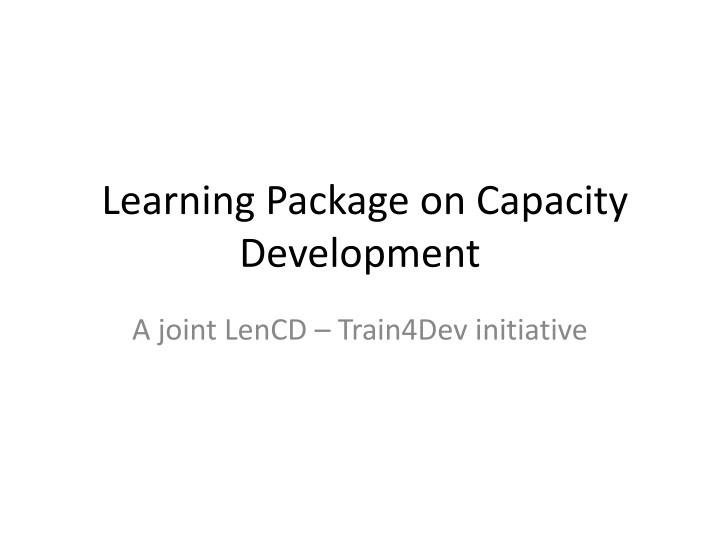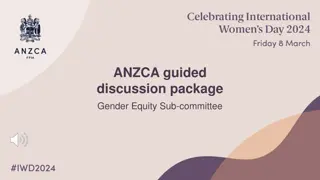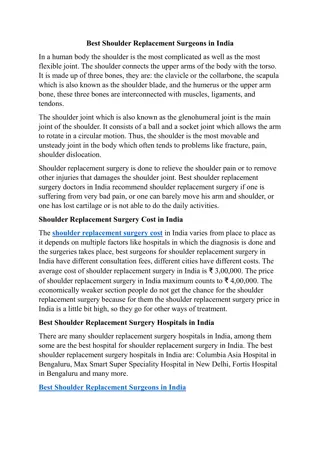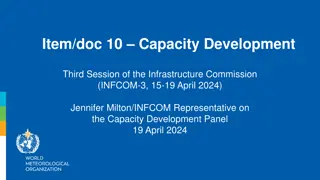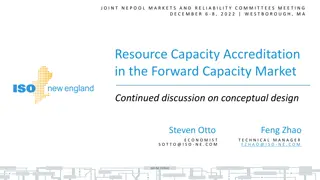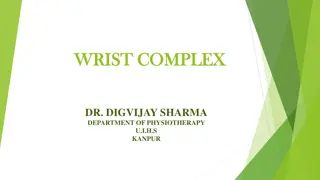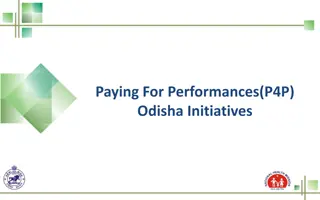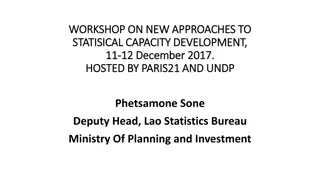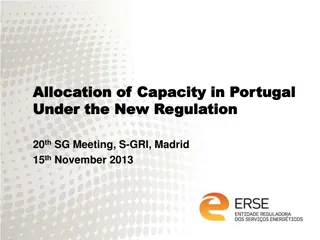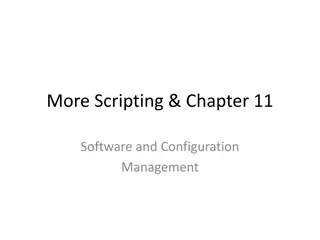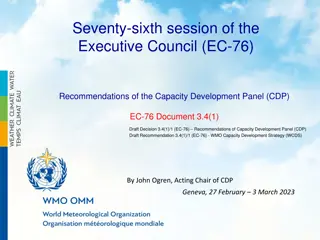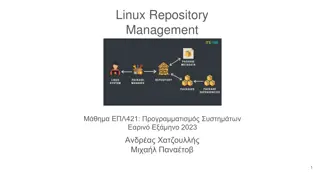Learning Package on Capacity Development: A Joint Initiative
This comprehensive learning package aims to facilitate sustainable capacity development by providing practical learning opportunities. It includes collaborative workshops, detailed drafts, field testing, and a joint learning journey. Designed to enhance knowledge and skills for practitioners at country and sector levels, in alignment with aid effectiveness agendas.
Download Presentation

Please find below an Image/Link to download the presentation.
The content on the website is provided AS IS for your information and personal use only. It may not be sold, licensed, or shared on other websites without obtaining consent from the author.If you encounter any issues during the download, it is possible that the publisher has removed the file from their server.
You are allowed to download the files provided on this website for personal or commercial use, subject to the condition that they are used lawfully. All files are the property of their respective owners.
The content on the website is provided AS IS for your information and personal use only. It may not be sold, licensed, or shared on other websites without obtaining consent from the author.
E N D
Presentation Transcript
Learning Package on Capacity Development A joint LenCD Train4Dev initiative
LenCD www.lencd.org The Learning Network on Capacity Development www.lencd.org Aim: to promote and facilitate sharing of lessons and learning on CD and promote changes for better practice at the global, regional and local levels An informal and open network of individuals and organisations sharing a common interest in improving CD practice Many agencies involved in different ways, UNDP holds as a project for management of funds www.LenCD.org & www.train4dev.net
Train4Dev www.train4dev.netThe Joint Donors' Competence Development Network (Train4Dev) www.train4dev.net Objective: to promote improved aid effectiveness for poverty reduction through enhanced donor co-operation in the field of competence development and training An open forum for donor agencies and multilateral organizations. Participating representatives are senior officials from training departments, technical departments or policy departments Operates by means of an annual meeting and Expert Groups working on priority themes or areas identified and endorsed by the annual meeting e.g. public financial management, CD www.LenCD.org & www.train4dev.net
Rationale for the Learning Package Many, especially at country and sector level, are struggling to understand what this means for them within the changing paradigm articulated in the Paris Declaration and Accra Agenda for Action A freely available virtual resource, designed to help country and sector level practitioners expand their knowledge and skills for facilitating sustainable CD The package is intended to respond to the need for practical learning opportunities about CD Current thinking is that CD is central to the aid effectiveness agenda. However www.LenCD.org & www.train4dev.net
Collaborative co-creation Workshop at the LenCD General Assembly in Kigali in February Package outline on the LenCD website (end March) Detailed working draft (end May) Workshop to review content and progress at Train4Dev annual meeting (1 June) First phase content ready for field testing (end June) Piloting use in Nairobi, Phnom Penh and Bad Honnef (August and September) Revisions and review of first phase achievements (October) Joint Learning Journey started by GIZ in Bad Honnef (November to May) www.LenCD.org & www.train4dev.net
Links to and builds on Training and Beyond: Seeking better practices for capacity development Which documents the changing paradigm in CD and what is emerging as a consensus about good practice Jenny Pearson (2011) OEDC Development Co-operation Working Papers, No. 1, OECD Publishing http://www.oecd-ilibrary.org/development/training-and- beyond-seeking-better-practices-for-capacity-development_5kgf1nsnj8tf- en;jsessionid=4ld21rkgpd5gq.delta www.LenCD.org & www.train4dev.net
The limits of training and learning Results based management At the simpler/lower levels of systems and their capacity needs RBM approaches can be helpful. The relevance and usefulness of RBM decreases as the complexity of the system increases. Complexity www.LenCD.org & www.train4dev.net
Learning Package overview/sitemap Core concept The importance of context Capacity development How to pages Trainer/facilitator s guide www.LenCD.org & www.train4dev.net
Core concept section Synthesis and overview: levels, types of capacity and themes for application Capacity: definitions and discussion CD: definitions and discussion including Where has it come from? The relevance of culture and context Towards a shared understanding Main current challenges: clarification of roles and responsibilities; results; supply vs. demand driven processes; and, starting with existing capacities www.LenCD.org & www.train4dev.net
- Core concept: Levels Levels are defined in various ways, including the following: Organisational Sectoral Institutional* Global Individual Some agencies, e.g. UNDP, call this the institutional level Some include linkages, networks, partnerships and sectors at this level Many agencies, e.g. the Swiss Agency for Development and Cooperation (SDC) have this level Some include linkages, networks and partnerships at this level This is the level of laws, policies and systems This level exists sub- nationally, nationally, regionally and globally This is often called the enabling environment Currently agencies concerned with climate change consider it essential to work at global level because of the complex interconnecti on of many environment al factors at the global level This is the only level that is common to all the different definitions of levels. Competencies, skills, knowledge and the abilities to use them, attitudes, values and culture can all be considered elements of an individual s overall capacity. * Institutional means the legal, policy and environmental context. This is sometimes also referred to as the enabling environment. www.LenCD.org & www.train4dev.net
- Core concept: Types Technical hard tangible Systems and procedures: management, planning, finance, human resources, M&E, PCM, etc. Laws, policies and strategies (enabling conditions) The ability to mobilise resources Technical skills, explicit knowledge and methodologies (also called competencies at the individual level) Organisational structures Note: tangible resources like money, buildings, equipment and documentation can be considered as the material expression or product of capacity, but they are not capacity in and of themselves. www.LenCD.org & www.train4dev.net
Social - soft - intangible Ability to analyse and adapt. Change readiness and change management Ability and willingness to learn and self-reflect. Tacit knowledge and experience Leadership Relational skills: negotiation, teamwork, conflict resolution, facilitation, etc. Confidence, empowerment , participation and legitimacy to act Political relationships and functioning Intercultural communication Organisational culture and values www.LenCD.org & www.train4dev.net
- Core concept: Themes for application Examples of themes for application according to need are: Human capacity; human resource development; leadership Fragile states (this is also considered to be a context) Examples of themes as drivers of change are: Democratic governance; accountability and transparency; citizen participation; ownership Institutional arrangements; systems and procedures; incentive structures; managing for capacity development results; organisational structures and interrelationships Knowledge and knowledge management www.LenCD.org & www.train4dev.net
Examples of themes used to create CD frameworks Ethiopian Civil Service Reform Programme: human capacity systems and procedures organisational structures and interrelationships Rwandan Public Sector Capacity Building Secretariat: capacity creation capacity utilization capacity retention each of which is applied at individual, organisational and institutional levels www.LenCD.org & www.train4dev.net
UNDP: accountability institutional arrangements knowledge leadership NEPAD Capacity Development Strategic Framework: leadership transformation citizen transformation knowledge and evidence based innovation utilizing African potential, skills and resources developing capacity of capacity developers integrated planning and implementation for results www.LenCD.org & www.train4dev.net
Definitions of capacity The availability of resources and the efficiency and effectiveness with which societies deploy these resources to identify and pursue their development goals on a sustainable That emergent combination of individual competencies, collective capabilities, assets and relationships that enables a human system to create value. ECDPM Capacity is the ability of people, organisations and society as a whole to manage their affairs successfully. OECD basis. WBI
Capacity or the ability to get things done goes beyond formal qualifications and technical skills development to include the cultivation of intangible or soft attributes such as the ability to drive change and to build processes, organizations, and institutions which can deliver public services over the long term. President Paul Kagame of Rwanda: The ability [of an organization] to function as a resilient, strategic and autonomous entity. CDRA (NGO)
- CD section Definitions Where has it come from? The origins of capacity development The Paris Declaration and Accra Agenda for Action The relevance of culture and context Reflection questions References for further reading www.LenCD.org & www.train4dev.net
Definitions of capacity and capacity development Many of the leading aid and development institutes have come to their own definition of capacity and capacity development However, the OECD definitions have been adopted by many other agencies, for example EuropaAid, GIZ and ADB Capacity is the ability of people, organisations and society as a whole to manage their affairs successfully. Capacity development is the processes whereby people, organisations and society as a whole unleash, strengthen, create, adapt and maintain capacity over time.
Other definitions of capacity development WBI: A locally driven process of learning by leaders, coalitions and other agents of change that brings about changes in sociopolitical, policy-related, and organizational factors to enhance local ownership for and the effectiveness and efficiency of efforts to achieve a development goal. CIDA: The activities, approaches, strategies, and methodologies which help organizations, groups and individuals to improve their performance, generate development benefits and achieve their objectives. USAID: Approaches, strategies, or methodologies used by USAID and its stakeholders to change, transform, and improve performance at the individual, organizational, sector, or broader system level. ECDPM: The process of enhancing, improving and unleashing capacity; it is a form of change which focuses on improvements.
Where has it come from? Capacity development builds on several previous approaches to aid and development. These are the building blocks of the current paradigm. PRACTICES STARTED ASSUMPTIONS Institution building: to create the institutions needed to manage the flow of aid Developing countries need money 1950s and 60s Institutional strengthening/development: Shift from establishing to strengthening institutions 1960s and 70s Development management/administration: Systems of public programs and capacity of government to reach target groups Developing countries should just model themselves after the developed ones 1970s Human resource development: Shift to thinking that development is about people with focus on education, health and population. New institutionalism: Focus on shaping national economic behaviour. Set the scene for the emergence of the governance focus that is now prominent 1970s, 80s 1980s, 90s
Capacity development has been emerging as a central approach within development for more than two decades, alongside continuing emphasis on aid, technical cooperation and technical assistance. The result is a development paradigm that is very complex, with many different sometimes conflicting components, agenda and priorities. The Accra Agenda for Action clearly set out the need for national ownership and leadership together with increasing emphasis on approaches such as South-South capacity development cooperation. The new approach is still emerging because it takes time to change attitudes and behaviour, and for new practices and experience to inform policy, practice and theory.
The relevance of culture and context In general terms a country s culture is the beliefs, norms and practices of its society, including religious and traditional beliefs, and they vary a great deal from one country to another. Culture can be very influential in terms of the achievement of development goals. An example is the belief in some cultures that it is more important to educate boys than girls. Context describes the combination of factors in a place or situation at any given time including: political and institutional systems, regional relationships, economic and physical factors. Context changes constantly, for example through the election of a new political party, new legislation, or the loss of important trade with a neighbouring country. Sometimes the context can change very quickly, as in several Asian countries in a matter of hours following the tsunami of 26th December 2004.
Culture and context define the relevance and limits of any type of capacity development intervention. Both are significant for scale up and transfer of good practice.
Approaches to CD Growing recognition that CD calls for multiple approaches, depending on type of need For soft skills Coaching and mentoring Communication techniques Experiential learning Exposure to good practice Leadership development For technical knowledge and skills Academic study programmes Blended learning Didactic or participatory training Distance learning E-learning For organisation and system level needs Knowledge management Organisational strengthening Partnerships and networks www.LenCD.org & www.train4dev.net
TOWARDS A SHARED UNDERSTANDING
Why is agreement needed? The challenges now are how to operationalise what is known to be good practice in order to achieve sustainable capacity and development results. There is a big need for a shared language and understanding, underpinned by some shared principles and values, of what capacity development is, why it is needed, and how to approach it. The point is not to try to make everyone think and work in exactly the same way: it is about having everyone operate within the same general framework so that we can be more effective in finding solutions relevant to each culture and context.
What is agreement needed about? Capacity development as a locally driven process Start from and build on existing capacities Shift from supply to demand driven initiatives Defining and measuring results
Capacity development as a locally driven process Local ownership is a prerequisite for sustainable capacity development. Donors are external actors, with a role to support the process of achieving local defined objectives and tasks. Ownership implies true and realistic commitment from the partner countries as well as flexibility from the donor s side to follow local leadership. More transparency is needed for joint accountability to achieving capacity development results.
Start from and build on existing capacities This is about the recognition of existing capacities and how to use them as the basis for moving forward. The shift to starting with an appreciation of what already exists and how to build on endogenous processes is not yet complete too often the focus is on the gap which can be a very negative starting point for action. All actors can do a lot to make this shift by changing the way they approach capacity assessments and the formulation of capacity goals and assessments before designing interventions.
Shift from supply to demand driven initiatives The Accra Agenda for Action recognised that the ownership and commitment of the partner countries is a prerequisite for sustainable capacity development. This means that local actors need to learn how best to define what capacity they need, how they think it can be developed in their culture and context, and how to negotiate and manage appropriate support from development partners. This also involves shifting towards longer term, programmatic approaches linked to locally formulated capacity development strategies.
Defining and measuring results While development results are relatively easy to define, there are many different ideas about how to define and measure capacity results within specific contexts. Capacity development is a long-term process tied to political agenda, without a predictable, linear path. Contexts like large urban systems or post- conflict countries are multi-dimensional, multi-level and multi-sectoral and require responses of similar complexity. In such circumstances the overall expected results can only be defined in broad terms and formats that do not always fit easily to current demands for measurement of results. The challenge is not so much about what do we want to achieve, as about how do we measure the effectiveness of our efforts to achieve it in ways that are meaningful for all stakeholders, not just donors.
The importance of context Resource listings on: Definitions, frameworks and theories General CD resources Internal agency learning resources Useful CD websites Useful books Other useful websites
How to pages, for practical ideas Map and influence stakeholders to get started Define and map a change process Work with incentives to stimulate change Assess change readiness, including analysis of the political economy Assess existing capacity and capacity needs Design the overall CD approach and an evolving mix of best fit methods and tools Establish partnerships and networks for scale up Formulate capacity goals and objectives Formulate capacity indicators for different contexts and levels Measure capacity outcomes and results for different levels and contexts Develop M&E processes to foster learning All available on the LenCD website, under the learning package section
Example: How to map stakeholders to get started What are the capacity issues you need to work on? Who are the other stakeholders with an interest? How - which methods, tools or approaches will be most effective? Gives a worked example of a provincial department where individuals have capacity but can t use it because of party political power struggles in senior management. The CD intervention needed is NOT technical skills. www.LenCD.org & www.train4dev.net
Trainer-facilitators guide Not a training manual Guidance notes on how to use the resources Sample workshop plans Sample exercises and reflection-learning questions
